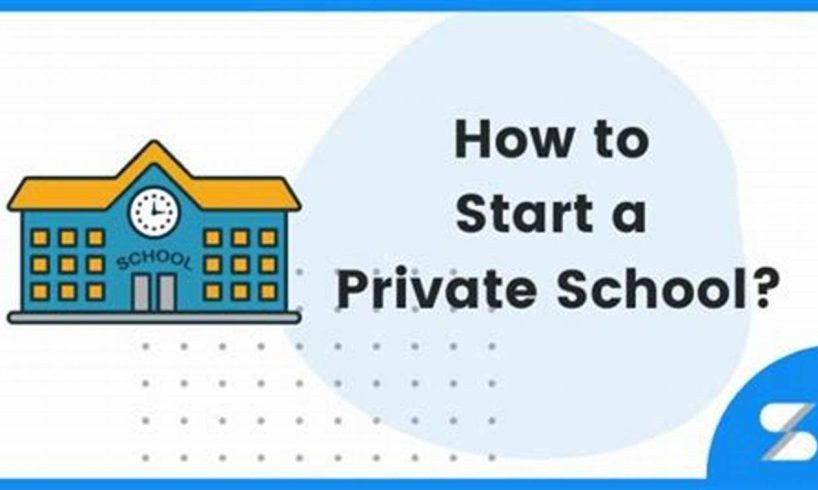
Starting a private school is a significant undertaking that requires careful planning and execution. It involves establishing a clear mission and educational philosophy, securing funding, obtaining legal and regulatory approvals, developing a curriculum, recruiting qualified staff, and marketing the school to prospective families.
Private schools offer a range of benefits, including smaller class sizes, individualized instruction, a focus on specific educational approaches or religious affiliations, and often enhanced extracurricular activities and facilities. They can be an attractive option for parents seeking a tailored educational experience for their children.
If you are considering starting a private school, there are several key steps to follow:
- Conduct thorough research: Explore different educational models, funding options, legal requirements, and best practices for private schools.
- Develop a comprehensive business plan: Outline your school’s mission, curriculum, staffing needs, financial projections, and marketing strategy.
- Secure funding: Private schools can be funded through a combination of tuition fees, grants, donations, and investments. Explore various funding sources and develop a sustainable financial model.
- Obtain legal and regulatory approvals: Comply with all applicable laws and regulations, including obtaining necessary licenses and permits from local and state authorities.
- Develop a curriculum: Design a curriculum that aligns with your school’s mission and educational philosophy. Consider the age and needs of your target student population.
- Recruit qualified staff: Hire experienced and passionate teachers who share your vision for the school and are committed to providing high-quality education.
- Market your school: Develop effective marketing strategies to reach your target audience. Highlight your school’s unique offerings and value proposition.
1. Mission and Values
The mission and values of a private school serve as its guiding principles, shaping its educational philosophy, curriculum, and overall culture. A clearly defined mission and values provide a strong foundation for all aspects of the school’s operation.
- Purpose
The school’s purpose defines its reason for existence and its unique contribution to the educational landscape. It articulates the school’s vision for the type of students it seeks to and the impact it aims to have on their lives.
- Educational Philosophy
The educational philosophy outlines the school’s approach to teaching and learning. It encompasses the school’s beliefs about how students learn best, the role of teachers, and the desired outcomes of the educational process.
- Core Values
The school’s core values are the fundamental principles that guide its decision-making and interactions with students, parents, and the community. They represent the ethical and moral compass of the school and shape its culture and ethos.
A strong mission and values statement provides a roadmap for the school’s development and ensures that all stakeholders are aligned in their understanding of the school’s purpose and priorities. It serves as a touchstone for decision-making and helps to maintain consistency and coherence in the school’s programs and activities.
2. Curriculum Development
Curriculum development is a central aspect of starting a private school. The curriculum is the heart of the educational program, and it must be carefully designed to align with the school’s mission and educational goals.
- Components of a Curriculum
A well-rounded curriculum includes a range of subjects and disciplines, such as language arts, mathematics, science, social studies, and the arts. It should also include opportunities for students to develop critical thinking, problem-solving, and communication skills.
- Alignment with Mission and Goals
The curriculum should be aligned with the school’s mission and educational goals. For example, if the school’s mission is to provide a well-rounded education that prepares students for college and beyond, the curriculum should include a rigorous academic program that emphasizes critical thinking and problem-solving.
- Flexibility and Adaptability
The curriculum should be flexible and adaptable to meet the needs of the students and the school. For example, the school may need to adjust the curriculum to accommodate students with different learning styles or to reflect changes in the educational landscape.
- Assessment and Evaluation
The curriculum should include a system for assessment and evaluation to track student progress and identify areas where students need additional support. This information can be used to improve the curriculum and ensure that students are meeting the school’s educational goals.
A well-designed curriculum is essential for the success of a private school. It provides a roadmap for teaching and learning, and it helps to ensure that students are receiving a high-quality education that is aligned with the school’s mission and educational goals.
3. Funding
Securing adequate funding is crucial for starting and operating a private school. A diverse range of funding sources helps ensure the school’s financial stability and sustainability. Tuition fees, grants, and donations are common funding sources for private schools, each with its own advantages and considerations.
Tuition fees are a primary source of funding for private schools. They cover the costs of operating the school, including teacher salaries, curriculum development, and facilities maintenance. Tuition fees can vary depending on the school’s location, size, and reputation.
Grants provide another source of funding for private schools. Grants are typically awarded by government agencies, foundations, or corporations to support specific educational programs or initiatives. Grants can be competitive, and schools must often submit detailed proposals to secure funding.
Donations are a valuable source of funding for private schools. Donations can come from individuals, families, businesses, and alumni. Donations can be used to support a variety of purposes, such as capital projects, scholarships, and faculty development.
A diverse funding portfolio is essential for the long-term success of a private school. By exploring various funding sources, schools can reduce their reliance on any one source and ensure their financial stability.
4. Legal Compliance
Legal compliance is of paramount importance when starting a private school. Operating within the boundaries of the law ensures the school’s legitimacy, protects the interests of students and staff, and maintains public trust.
- Licensing and Accreditation
Most states require private schools to obtain a license to operate. Licensing typically involves meeting specific standards related to curriculum, teacher qualifications, and facilities. Accreditation is a voluntary process that demonstrates a school’s commitment to quality and continuous improvement. Accreditation agencies evaluate schools based on a set of standards and grant accreditation to those that meet their criteria.
- Compliance with Education Laws
Private schools must comply with all applicable education laws, including those related to special education, student discipline, and teacher certification. Failure to comply with these laws can result in legal consequences, including fines or even closure of the school.
- Health and Safety Regulations
Private schools must also comply with all applicable health and safety regulations. These regulations cover a wide range of areas, such as building safety, fire safety, and food handling. Compliance with these regulations helps to ensure the health and well-being of students and staff.
- Employment Laws
Private schools are subject to all applicable employment laws, including those related to hiring, firing, and discrimination. Compliance with these laws helps to protect the rights of employees and ensures a fair and equitable workplace.
Maintaining legal compliance is an ongoing process that requires schools to stay abreast of changing laws and regulations. By doing so, schools can protect their legal interests, maintain their reputation, and provide a safe and supportive learning environment for students.
5. Staffing
Assembling a team of qualified educators who share the school’s vision and values is crucial for the success of any private school. Effective teachers are not only knowledgeable in their subject matter but also passionate about teaching and committed to the holistic development of their students.
- Attracting Top Talent
To attract the best educators, private schools need to create a work environment that is both challenging and supportive. This includes offering competitive salaries and benefits, providing opportunities for professional development, and fostering a culture of collaboration and respect.
- Cultural Alignment
It is essential to hire educators who align with the school’s mission and values. This ensures that they are committed to the school’s educational philosophy and are invested in the success of all students.
- Qualifications and Experience
While cultural alignment is important, it is equally crucial to ensure that educators possess the necessary qualifications and experience. This includes not only subject matter expertise but also strong pedagogical skills and a deep understanding of child development.
- Diversity and Inclusion
A diverse and inclusive staff brings a wealth of perspectives and experiences to the school community. This not only benefits students by exposing them to different cultures and backgrounds but also creates a more vibrant and stimulating learning environment.
By carefully recruiting and hiring qualified educators who share the school’s vision and values, private schools can create a strong foundation for academic excellence and student success.
6. Marketing and Outreach
In the competitive landscape of education, marketing and outreach are essential aspects of starting a private school. A well-defined marketing and outreach strategy helps schools differentiate themselves, attract prospective families, and secure enrollment.
- Target Audience Identification
Effective marketing begins with identifying the target audience, which includes prospective students and their families. Schools need to understand their target audience’s demographics, interests, and educational needs to tailor their marketing messages accordingly.
- Unique Value Proposition
Private schools need to clearly articulate their unique value proposition to stand out from competitors. This involves highlighting the school’s strengths, such as its educational philosophy, curriculum, extracurricular activities, and faculty expertise.
- Multi-Channel Marketing
To reach the target audience effectively, schools need to employ a multi-channel marketing approach. This includes using a mix of traditional channels like print advertising and direct mail, as well as digital channels like social media, email marketing, and search engine optimization.
- Community Engagement
Building relationships with the local community is crucial for private schools. By participating in community events, hosting open houses, and partnering with local organizations, schools can raise their visibility and attract prospective families who are invested in the community.
A well- executed marketing and outreach strategy is essential for the success of any private school. By effectively promoting their unique value proposition and engaging with the community, schools can increase their visibility, attract prospective families, and secure enrollment.
7. Assessment and Evaluation
Assessment and evaluation are crucial components of a successful private school. They provide valuable data that can be used to improve teaching and learning, monitor student progress, and ensure that the school is meeting its goals.
- Student Progress Monitoring
Regularly assessing student progress helps teachers identify areas where students are struggling and need additional support. This information can be used to adjust instruction and provide targeted interventions to help students succeed.
- School Effectiveness Evaluation
Evaluating the school’s effectiveness as a whole helps identify areas where the school can improve its programs and services. This information can be used to make data-driven decisions that will benefit all students.
- Accountability and Transparency
Assessment and evaluation systems provide accountability and transparency to parents and the community. They demonstrate the school’s commitment to providing a high-quality education and help ensure that the school is meeting its mission.
- Continuous Improvement
Assessment and evaluation are essential for continuous improvement. By regularly collecting and analyzing data, schools can identify areas where they can improve their teaching and learning practices. This leads to a cycle of continuous improvement that benefits all stakeholders.
Effective assessment and evaluation systems are essential for any private school that wants to provide a high-quality education and ensure student success.
FAQs on How to Start a Private School
Starting a private school is a significant undertaking that involves careful planning and execution. Here are answers to some frequently asked questions to provide further guidance:
Question 1: What are the key steps involved in starting a private school?
The key steps include developing a mission and educational philosophy, securing funding, obtaining legal and regulatory approvals, developing a curriculum, recruiting qualified staff, and marketing the school.
Question 2: What are the essential components of a strong mission and values statement for a private school?
A strong mission and values statement should define the school’s purpose, educational philosophy, and core values that guide its decision-making and interactions.
Question 3: How can a private school ensure that its curriculum aligns with its mission and educational goals?
The curriculum should be carefully designed to reflect the school’s mission and goals, including the subjects and disciplines covered, teaching methodologies, and assessment strategies.
Question 4: What are the primary sources of funding for private schools, and how can schools diversify their funding portfolio?
Primary funding sources include tuition fees, grants, and donations. Schools can diversify their funding by exploring various grant opportunities, seeking corporate partnerships, and building a strong donor base.
Question 5: What legal and regulatory requirements must private schools comply with, and why is compliance important?
Compliance with laws and regulations, including licensing, accreditation, and adherence to educational and employment laws, is crucial for maintaining the school’s legitimacy, protecting stakeholders’ interests, and ensuring a safe and supportive learning environment.
Question 6: How can private schools attract and retain qualified educators who share their vision and values?
Attracting and retaining qualified educators involves creating a positive work environment, offering competitive compensation and benefits, providing professional development opportunities, and fostering a culture of collaboration and shared values.
These FAQs provide a concise overview of key considerations for starting a private school. By addressing these aspects, schools can lay a solid foundation for their educational mission and contribute to the diverse landscape of educational options.
Transition to the next article section: “Benefits and Challenges of Starting a Private School”
Tips for Starting a Private School
Launching a private school requires careful planning and execution. Here are several essential tips to guide you through the process:
Tip 1: Define a Clear Mission and Values
Establish athat articulate the school’s purpose, educational philosophy, and guiding principles. This foundation will shape all aspects of the school’s operation.
Tip 2: Secure Diverse Funding Sources
Explore various funding streams, including tuition fees, grants, donations, and partnerships, to ensure the school’s financial stability and sustainability.
Tip 3: Develop a Comprehensive Curriculum
Design a curriculum that aligns with the school’s mission and educational goals. Consider the age and needs of your target student population, and ensure the curriculum is engaging, rigorous, and relevant.
Tip 4: Recruit and Hire Qualified Staff
Seek passionate and experienced educators who share the school’s vision and values. Provide opportunities for professional development to support their growth and ensure they are equipped to deliver high-quality instruction.
Tip 5: Market and Promote the School Effectively
Develop a comprehensive marketing strategy to reach your target audience. Highlight the school’s unique offerings, values, and the benefits it provides to students.
Tip 6: Ensure Legal Compliance and Accreditation
Comply with all applicable laws and regulations, including obtaining necessary licenses and accreditation. This ensures the school’s legitimacy, credibility, and adherence to established educational standards.
Tip 7: Establish a System for Assessment and Evaluation
Implement systems to monitor student progress, evaluate the effectiveness of the curriculum and teaching methods, and make data-driven decisions to continuously improve the school’s educational outcomes.
Tip 8: Foster a Positive and Inclusive School Culture
Create a welcoming and supportive school environment that values diversity, equity, and inclusion. Encourage open communication, collaboration, and a sense of community among students, staff, and parents.
Summary
By following these tips, you can increase your chances of success when starting a private school. Remember to conduct thorough research, develop a solid plan, and seek support from experts and stakeholders throughout the process.
Conclusion
Launching a private school is a significant undertaking that demands careful planning, resourcefulness, and a commitment to educational excellence. By defining a clear mission and values, securing diverse funding, developing a comprehensive curriculum, recruiting qualified staff, and ensuring legal compliance, schools can lay a solid foundation for their educational mission.
The success of any private school hinges on its ability to adapt to a dynamic educational landscape and continuously improve its offerings. Schools must foster a positive and inclusive school culture, embrace innovation, and actively seek feedback from stakeholders to remain relevant and responsive to the evolving needs of students and the community. By doing so, private schools can make meaningful contributions to the educational landscape and provide students with transformative learning experiences that empower them to thrive in the 21st century and beyond.






